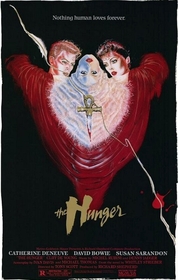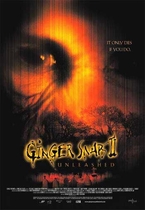Our editor-in-chief Nate Yapp is proud to have contributed to the new book Hidden Horror: A Celebration of 101 Underrated and Overlooked Fright Flicks, edited by Aaron Christensen. Another contributors include Anthony Timpone, B.J. Colangelo, Dave Alexander, Classic-Horror.com's own Robert C. Ring and John W. Bowen. Pick up a copy today from Amazon.com!
The Hunger (1983)
It was 1983 and the age of MTV. If video had really killed the radio star, he was resurrected on film as one of the most stylish vampires since Bela Blasko changed his name and donned a cape. Casting David Bowie as centuries old vampire John Blaylock was the hook to lure the MTV audience but the real stars of director Tony Scott’s (Ridley’s younger brother) modern day “Symphony of Horror,” are Catherine Deneuve and Susan Sarandon as predator and prey. Deneuve as Blaylock’s vampire bride Miriam, and Sarandon as Dr. Sarah Roberts heat up the screen with so much sexual and emotional tension, that the eventual release is hot enough to melt a TV screen. However don’t be fooled. The Hunger is much more than just a retread of the Hammer vampire lesbian story. It is a multi-layered visual and thematic onslaught with nuances often overlooked.
Often dismissed as quick-cut, music-video derivative pulp, The Hunger actually has the notion of “style versus substance” woven intricately into the rich fabric of its subtext. The human attraction to aesthetic beauty is undeniable. In our culture it is an obsession. Often those prized aesthetic qualities are displayed most in the young, beautiful people. Beauty and youth is such an obsession death does not scare us as much as simply getting old. The vampire mythos is ripe with the lure of eternal youth and the blood-drinking duo of Miriam and John Blaylock serves no exception.
In the opening sequence, strains of the ultra-hip (in 1983) goth band Bauhaus’s ode to vampire style, "Bela Lugosi is Dead," underscore Miriam and John scouting an alluring young couple in a club, their sexual dominance over the youths and their eventual “climax.” Beauty, youth, sex, violence and death are immediately fused into one white hot, dysfunctional image and remain forged as one for the rest of the film. Miriam and John feed not only to stay alive, but young. You are what you eat as the saying goes.
As flashy as the movie starts, it changes pace, transitioning from the music of Bauhaus to a classical trio. We soon learn that John and Miriam while both vampires, are very different. It is implied that Miriam turned John sometime during the eighteenth century, pledging her love and their youth “forever.” In the present, John becomes pensive, sensing a change in himself. He shows signs of age. Miriam at once begins to exhibit cold, distant behavior to him. As John’s aging increases at an astonishing rate (with phenomenally realistic makeup by Dick Smith, the man responsible for aging Dustin Hoffman a century in Little Big Man) Miriam begins to seek another companion to replace John. She is choosing style over substance, the hot new thing instead of the old standard. She eventually boxes away the decrepitly aged but eternally undying John as she had all her previous lovers. That is the part that Miriam never mentioned to John. She lied to him, denying him knowledge of his eventual fate of decomposed living death, to keep herself from being alone. Beauty, youth, sex, violence and death again are displayed, but from a different view. We see Miriam weep, but the reason could be guilt rather than lost love. The Hunger of the title is more than the lust for blood or eternal youth, for Miriam it’s also the aching emptiness of being alone. It’s obvious that Miriam knows what she does is wrong, yet she does it because it’s easier for her than being alone.
With her vampiric feminine wiles, Miriam seduces research scientist Dr. Sarah Roberts (Susan Sarandon). An author and expert on the subject of aging, Sarah had been visited by John seeking help for his rapid decline. Sarah, intrigued by all the mysteries that she experiences with the Blaylocks, can’t seem to say no to the beguiling Miriam. We see how Miriam has recruited all her former partners in her conquest of Sarah. Sarah realizes what is happening and tries to resist, but is met with the mantra of all abusive lovers, “You need me.” We see how cruel and shallow Miriam truly is in that instant. Her fear is that she will be alone and she will go to any lengths to escape it.
In a subplot involving a young girl first befriended by the Blaylocks, then used like so many others before, we are shown the extreme of youth and innocence juxtaposed against the age and selfishness of the Blaylocks. At one point the girl, Alice, in talking about her mother’s prescription drug habit says of her mother, “She’s afraid of getting’ old.” As she is preyed upon by age incarnate, she is frozen forever young and spared “getting’ old.”
In a thrilling climax harkening images from EC Comics, Miriam is forced face to face with her misdeeds. “Instant Karma’s gonna get you…” In the epilogue, we are left with the cycle complete. The former abused has become the abuser, style insidiously overpowers substance and the Hunger will again need to be satisfied.








